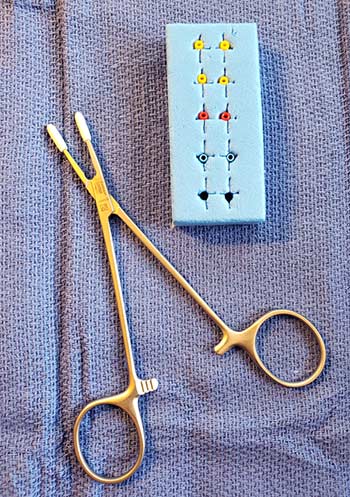- Home
- The Stitch
- The Stitch Article
Handling Forensic Specimens
By: Sara Angelilli, DNP, MS, RN, CNOR, NPD-BC
Published: 4/4/2024
Your knowledge of forensic specimen handling is critical to ensure that all potential sources of evidence are protected during patient care and surgical procedures. Forensic evidence may be used in a court of law during legal proceedings. If forensic evidence is mishandled or lost, that evidence will not be available if needed in settlements and hearings. This article will describe what forensic evidence is and provide recommendations for handling it to maintain integrity.
What is Forensic Evidence?
Forensic evidence describes objects that are gathered from crime scenes, patient care activities, or autopsies that are protected for future admission in a court of law for crime investigation. Forensic evidence may include projectiles (eg, bullets), knives or other weapons, pills or powders, and biological evidence.1 Evidence may be collected from your patient’s clothing, the surface of their hands, or under their fingernails. In the OR, you may be removing bullets or weapons that are lodged inside a patient. Any items removed from the patient must be maintained in a chain of custody to prove that no one tampered with the evidence.1,2
Considerations for Handling Forensic Evidence
Your hospital policy will help you determine specific steps to take that will protect the evidence collected. There are many general considerations for forensic evidence collection.1,2
General Considerations for Handling Forensic Evidence1,2
- Wear personal protective equipment when handling evidence, to protect the item and yourself and to prevent cross-contamination with additional biological materials.
- Personal protective equipment should include gloves, at a minimum, and may include a gown or goggles if there is a splash risk present when collecting evidence.
- Collect the items as soon as possible and minimize handling of the objects to preserve the integrity of the evidence while providing patient-centered care.
- Secure the patient’s hands in paper bags using tape to preserve any evidence on their hands or under their fingernails, including blood, gunpowder, or other materials.
- When indicated by your facility policy or at the request of local law enforcement, capture photography before evidence is removed and the surgical prep is performed.
- Photographs may be used to identify patient injuries.
- Minimize handling of objects to prevent the loss of evidence or cross-contamination with other materials.
- Do not rinse, wash, or wipe evidence, including the patient’s hands, because this will have an impact on the amount of evidence available and the integrity of the evidence collected.
- Remove clothing from the patient by cutting near the seams or around bullet or stab holes to preserve evidence and the shape of the hole.
- Retrieve bullets using nonmetal instruments or instruments with rubber shods to preserve firing patterns on the surface of the bullet.
- Document forensic evidence in the patient’s medical record, including the location where the evidence was found or removed.
Chain of Custody
Forensic specimens are collected at the request of law enforcement officers who will pick up the items directly from the medical team on retrieval. Forensic specimens are accompanied by a paper log that tracks possession of the evidence from the time it is obtained from the patient until it is turned over to local law enforcement. The documentation should include the date, time, type of evidence, and the names of the people who receive and deliver the evidence. When the evidence is turned over to a law enforcement official, their name and badge number is recorded in the log. This process protects the integrity of the evidence so that it can be accepted for admission in court.
Download a sample Chain of Custody Form
Special Considerations
There are special considerations for retrieving and handling ballistic evidence. When the surgical team is retrieving bullets from a patient, it is important to use nonmetal instruments or instruments with shods (Figure 1). Instrument shods are rubber tips that are used to cover the metal tips of a clamp. Bullet retrieval with nonmetal instruments is crucial to prevent scratching the surface of the bullet. Bullets can be matched to the firing weapon by the markings and the firing pattern imprinted on the surface of the bullet.

Figure 1. Instrument shods are rubber tips used to cover the metal tips of a clamp.
Every forensic specimen must be packaged individually in an appropriate container that is labeled with the patient’s information. Clothing is packaged in paper bags to prevent deterioration, condensation, or growth of microbes. Bullets are packaged in plastic containers to preserve markings or firing patterns captured on metal surfaces. The label should include your hospital’s chosen patient identification information, date, and time of collection.
References
- Rothrock J. Alexander’s Care of the Patient in Surgery. 17th ed. St Louis, MO: Elsevier; 2023.
- Guideline for specimen management. Guidelines for Perioperative Practice. Denver, CO: AORN, Inc; 2024:915-958.

